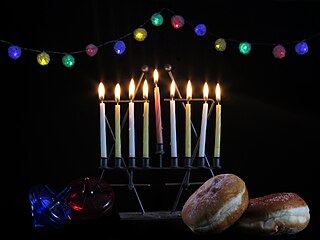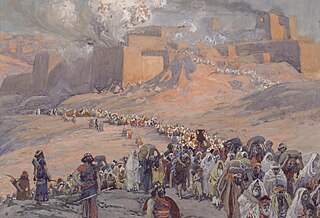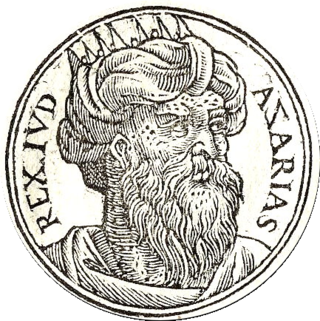Related Research Articles

Hanukkah is a Jewish festival commemorating the recovery of Jerusalem and subsequent rededication of the Second Temple at the beginning of the Maccabean Revolt against the Seleucid Empire in the 2nd century BCE.

Ezra or Esdras, also called Ezra the Scribe in Chazalic literature and Ezra the Priest, was an important Jewish scribe (sofer) and priest (kohen) in the early Second Temple period. In Greco-Latin Ezra is called Esdras. His name is probably a shortened Aramaic translation of the Hebrew name עזריהו Azaryahu, "Yah helps". In the Greek Septuagint the name is rendered Ésdrās, from which the Latin name Esdras comes.

The Babylonian captivity or Babylonian exile is the period in Jewish history during which a large number of Judeans from the ancient Kingdom of Judah were captives in Babylon, the capital city of the Neo-Babylonian Empire, following their defeat in the Jewish–Babylonian War and the destruction of Solomon's Temple in Jerusalem. The event is known to be historical, and is described in archaeological and extra-biblical sources, in addition to the Hebrew Bible.
Bagoas was a prominent Persian official who served as the vizier of the Achaemenid Empire until his death.

The Elephantine Papyri and Ostraca consist of thousands of documents from the Egyptian border fortresses of Elephantine and Aswan, which yielded hundreds of papyri and ostraca in hieratic and demotic Egyptian, Aramaic, Koine Greek, Latin and Coptic, spanning a period of 100 years in the 5th to 4th centuries BCE. The documents include letters and legal contracts from family and other archives, and are thus an invaluable source of knowledge for scholars of varied disciplines such as epistolography, law, society, religion, language and onomastics. The Elephantine documents include letters and legal contracts from family and other archives: divorce documents, the manumission of slaves, and other business. The dry soil of Upper Egypt preserved the documents.

Uzziah, also known as Azariah, was the tenth king of the ancient Kingdom of Judah, and one of Amaziah's sons. Uzziah was 16 when he became king of Judah and reigned for 52 years. The first 24 years of his reign were as a co-regent with his father, Amaziah.
Yohananיוֹחָנָן, sometimes transcribed as Johanan is Hebrew male given name that can also appear in the longer form of יְהוֹחָנָן, meaning "YHWH is gracious".

John Hyrcanus was a Hasmonean (Maccabean) leader and Jewish high priest of the 2nd century BCE. In rabbinic literature he is often referred to as Yoḥanan Cohen Gadol, "John the High Priest".

Judah Aristobulus I or Aristobulus I was the first Hasmonean king of Judaea from 104 BCE until his death in 103 BCE. He was the eldest of the five sons of John Hyrcanus, the previous leader. The Romano–Jewish historian Josephus states that he was the first Jew in "four hundred and eighty-three years and three months" to have established a monarchy since the return from the Babylonian captivity. Aristobulus was the first Hebrew king to claim both the high priesthood and the kingship. The Sadducees and the Essenes were not concerned about Aristobulus taking the title of king, but the Pharisees, believing that the kingship could only be held by the descendants of the Davidic line, strongly opposed this. They launched a massive rebellion, but Aristobulus died before any attempt to depose him could happen.

Mattathias ben Johanan was a Kohen who helped spark the Maccabean Revolt against the Hellenistic Seleucid Empire. Mattathias's story is related in the deuterocanonical book of 1 Maccabees. Mattathias is accorded a central role in the story of Hanukkah and, as a result, is named in the Al HaNissim prayer Jews add to the Birkat Hamazon and the Amidah during the festival's eight days.

Nehemiah is the central figure of the Book of Nehemiah, which describes his work in rebuilding Jerusalem during the Second Temple period. He was governor of Persian Judea under Artaxerxes I of Persia.
Sanballat the Horonite – or Sanballat I – was a Samaritan leader, official of the Achaemenid Empire, and contemporary of the Israelite prophet Nehemiah who lived in the mid-to-late 5th century BC. He and his family are mentioned in the contemporary Elephantine papyri and ostraca.

The Yehud coinage is a series of small silver coins bearing the Aramaic inscription Yehud. They derive their name from the inscription YHD (𐤉𐤄𐤃), "Yehud", the Aramaic name of the Achaemenid Persian province of Yehud; others are inscribed YHDH, the same name in Hebrew. The minting of Yehud coins commenced around the middle of the fourth century BC, and continued until the end of the Ptolemaic period.
Joiada is a name found from the form "Jehoiada" in the Hebrew Bible and used alternately in English versions.
"The Jeshanah Gate was repaired by Joiada son of Paseah and Meshullam son of Besodeiah. They laid its beams and put its doors with their bolts and bars in place"
Eliashib the High Priest is mentioned in Nehemiah 12:10,22 and 3:1, 20-21,13:28 and possibly the Book of Ezra of the Hebrew Bible as (grand)father of the high priest Johanan. Some also place him in different parts of Nehemiah including 12:23 and 13:4,7, but this is disputed. Nehemiah 3:20-21 places his home between the area of two working groups constructing the walls of Jerusalem on the south side of the city. He helped with the refortification of this wall. The size of his house indicated his wealth and high socio-economic status. This places him as someone who lived during the time of Nehemiah. In the year 445 BCE, Eliashib was the high priest when Nehemiah returned to Jerusalem in the 20th year of Artaxerxes I.
Joiakim is the name of a priest mentioned in the Hebrew Bible, in Deuterocanonical books, and in later extra-biblical sources. Reconstructing his role in history is complicated by a variety of claims made in these texts. The chronology of Joiakim's tenure as priest has been the subject of dispute, as has the question of whether Joiakim was high priest. The Hebrew Bible, which mentions Joiakim only in the Book of Nehemiah, Chapter 12, does not call him "high priest," though Josephus does use the term for him.

Yehud Medinata, also called Yehud Medinta or simply Yehud, was an autonomous administrative division of the Achaemenid Persian Empire. It constituted a part of Eber-Nari and was bounded by Arabia to the south, laying along the frontier of the two satrapies. Spanning most of Judea—from the Shephelah in the west to the Dead Sea in the east—it was one of several Persian provinces in Palestine, together with Moab, Ammon, Gilead, Samaria, Ashdod, and Idumea, among others. It existed for just over two centuries before the Greek conquest of Persia resulted in it being incorporated into the Hellenistic empires.

The Arad ostraca, also known as the Eliashib Archive, is a collection of more than 200 inscribed pottery shards found at Tel Arad in the 1960s by archeologist Yohanan Aharoni. Arad was an Iron Age fort at the southern outskirts of the Kingdom of Judah, close to Beersheba in modern Israel.
References
- 1 2 Antiquities xi. 7.1, Josephus
- 1 2 Pritchard, James B. ed., Ancient Near Eastern Texts Relating to the Old Testament, Princeton University Press, third edition with supplement 1969, p. 492
- 1 2 Betlyon, John Wilson, "The Provincial Government of Persian Period Judea and the Yehud Coins" Journal of Biblical Literature Vol. 105, No. 4 (Dec., 1986), pp. 639–642
- ↑ YHD 25 (Yehud coin Type 25): Hemiobol with facing head/owl and inscription Yohanan the Priest. The Menorah Coin Project website. Israel Numismatic Society
- 1 2 Fried, Lisbeth S., A silver coin of Yohanan Hakkôhen , Transeuphratène 26 (2003) pp. 67, 85
- ↑ Gitler H., Lorber C., Fontanille J.-P. (2023), The Yehud Coinage: A Study and Die Classification of the Provincial Silver Coinage of Judah. (Introduction) Israel Numismatic Society; Jerusalem, Israel.
- ↑ The Menorah Coin Project website. Israel Numismatic Society
- ↑ Antiquities 11:297–302, Josephus
- ↑ From Joshua To Caiaphas: High Priests after the Exile 54–63, James Vander Kam